NVIDIA Shield Review: At the Crossroads of PC and Mobile Gaming
by Brian Klug on July 31, 2013 12:14 AM ESTGPU Performance - 3DMark
The GPU performance story is finally a competitive one for NVIDIA. Although Tegra 4 lacks full OpenGL ES 3.0 compliance, it does finally dedicate enough SoC die area to GPU performance to compete with the likes of Apple and the iPad with Retina Display. We'll start with 3DMark, which is Android and Windows only at this point.
3DMark for Android features the Ice Storm benchmark and uses OpenGL ES 2.0. Ice Storm is divided into two graphics tests and a physics test. The first graphics test is geometry heavy while the second test is more pixel shader intensive. The physics test, as you might guess, is CPU bound and multithreaded. The overall score takes into account both graphics and physics tests. The benchmark is rendered to an offscreen buffer at 720p/1080p and then scaled up to the native resolution of the device being tested. This is a very similar approach we've seen by game developers to avoid rendering at native resolution on some of the ultra high resolution tablets. The beauty of 3DMark's approach here is the fact that all results are comparable, regardless of a device's native resolution. The downside is we don't get a good idea of how some of the ultra high resolution tablets would behave with these workloads running at their native (> 1080p) resolutions.
Here we see Tegra 4 in Shield outperforming all of the shipping players on Android, and virtually tying with Adreno 330 in Qualcomm's upcoming MSM8974 (Snapdragon 800 platform). Tegra 4's GPU performance is still no where near even Intel's HD 4000, but we're seeing massive improvements in raw FP throughput in ultra mobile GPUs. I'm very eager to see what's possible once Kepler makes its way into NVIDIA's mobile SoCs next year with Logan.
The 3DMark Physics test is also worth looking at as it shows a 36% increase in performance over four Krait 300 cores running at 1.5GHz. There are faster Krait 300s out there, but another 13% isn't enough to make up this gap. The Krait 400 comparison is much closer, but the Krait 400s have to be clocked at 2.3GHz to equal the performance of the 1.9GHz Cortex A15s. It remains to be seen which combination is ultimately lower power.
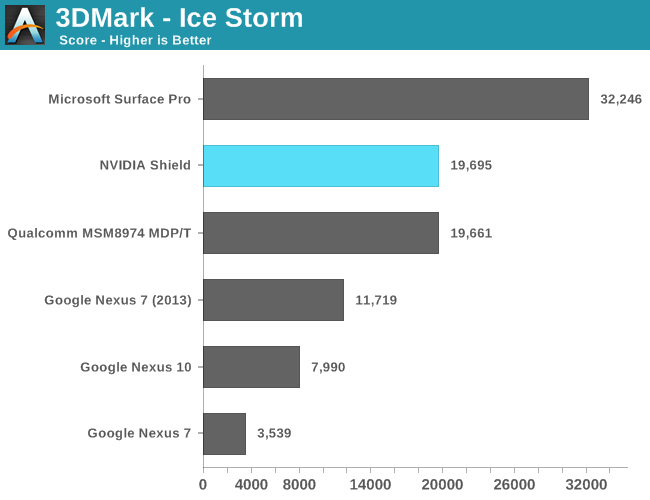

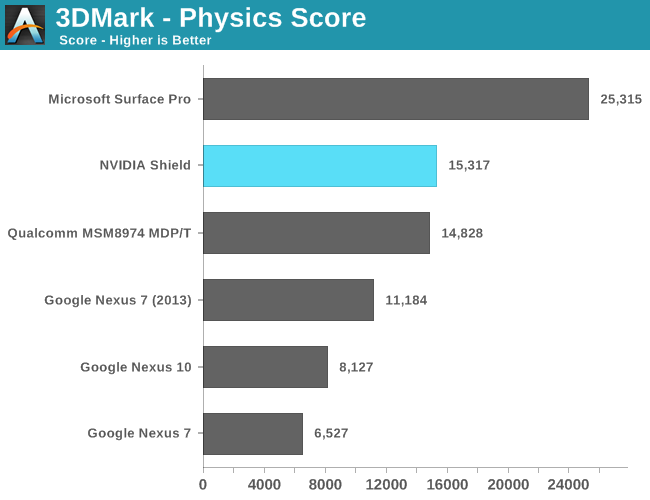
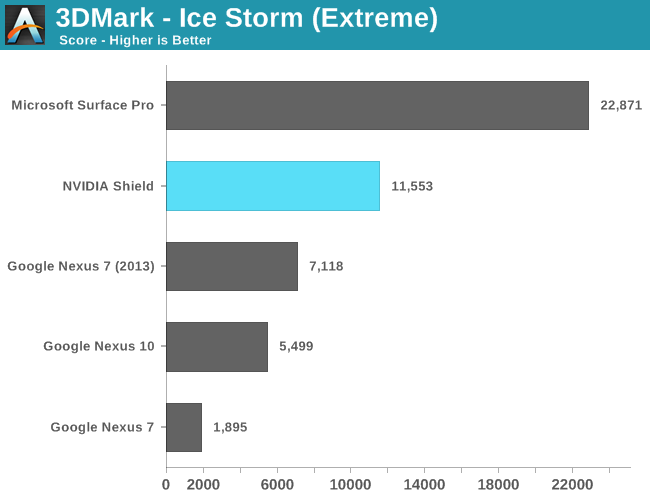
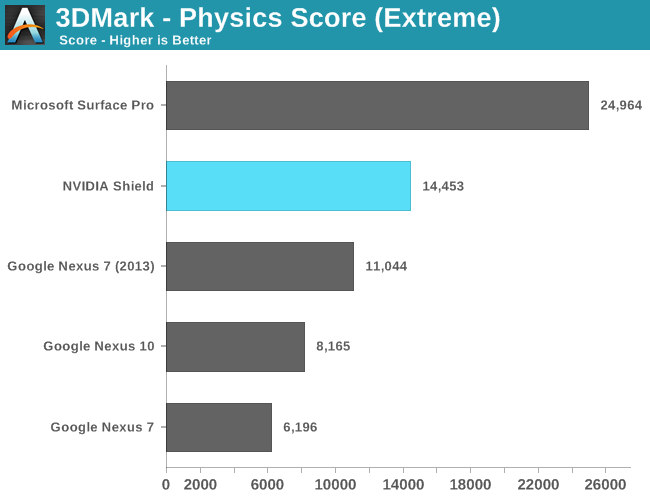

Basemark X
Basemark X is a new addition to our mobile GPU benchmark suite. There are no low level tests here, just some game simulation tests run at both onscreen (device resolution) and offscreen (1080p, no vsync) settings. The scene complexity is far closer to GLBenchmark 2.7 than the new 3DMark Ice Storm benchmark, so frame rates are pretty low.
In both tests, NVIDIA posts big gains over anything presently shipping from the Android camp. Adreno 330 pulls ahead on a level playing field, holding a 24% performance advantage over Tegra 4.
I would've loved to have seen this sort of competition from NVIDIA back when the iPad 4 launched, but it's at least good to see NVIDIA move from being a value player with Tegra 3 to a high performance contender with Tegra 4.
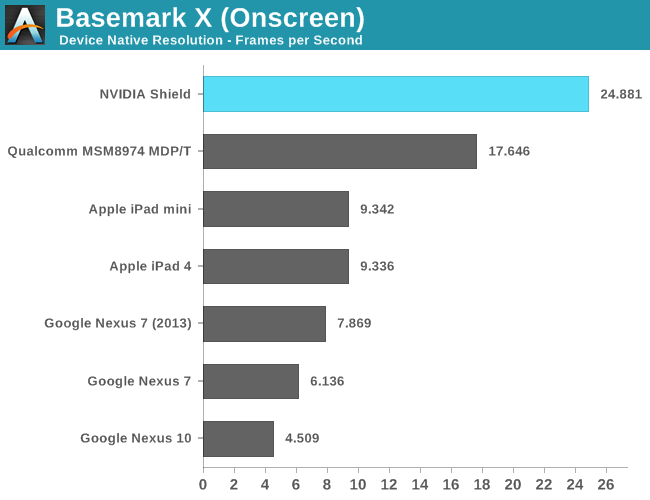











134 Comments
View All Comments
fr33h33l - Wednesday, July 31, 2013 - link
Nice review as always and good to see Shield and Tegra 4 finally shipping.I am curious though as to what has led to the (so far) low adoption rate of Tegra 4, especially in contrast to the almost performance-wise equivalent Snapdragon 800. Was it just a matter of time-to-market, or was it deal negotiation issues, or as some say (without providing conclusive evidence) that Tegra 4 is inferior to Snapdragon 800 in power efficiency?
Does anyone have more insights (as opposed to unsubstantiated rumors) into this?
Spunjji - Thursday, August 1, 2013 - link
Previously mentioned Amazon reviews for the Toshiba Excite Pro indicate overheating issues and poor battery life. That's not as good as a proper analysis but I'd hesitate to call it unsubstantiated.fteoath64 - Saturday, August 3, 2013 - link
A lot of people are curious about this same question :"Is Tegra 4 is inferior to Snapdragon 800 in power efficiency?". I would agree that it is a yes but not by much. The issue for both chips are that they are overkill (in battery sapping rate) for phone implementation and more suitable for large tablet and console use such as Shield. I think the issue of T4 is its TTM just kills the market opportunity and also the fact that Qualcomm has had multiple solutions to match/counter the old T3 design wins and hence snags them all!. It is a pity for Nvidia but the market is rather brutal due to fierce competition. Even Intel cannot muscle themselves in with the new Atom chip. Not that it is good enough or low priced (huh!). This T4 device at least gives the market some sort of benchmark in comparing its performance in detail over the coming weeks. The S800 tablets are not as forthcoming as we hoped so there is plenty of time to determine some much wanted data.It is interesting to see the SnapDragon S4 Pro chip being used in Nexus 7 and Moto X, new Droid range as well especially when the flagship S600 was doing so well. Is there a radical price difference , I wonder ...
WeaselITB - Wednesday, July 31, 2013 - link
Didn't see it in the review, but I'm curious how well it performs streaming PC game to Shield to HDMI cable plugged into a TV. Cabling get in the way? Problems with battery life in this scenario? How well does the high-res PC compress down to stream to the Shield, then upconvert back to 1080p for the TV? What about transition from sitting on the couch with the cable plugged into the TV, then unplugging the cable to walk into the kitchen, any glitches with transitioning back to the in-device screen?marraco - Wednesday, July 31, 2013 - link
I wish I had a PC client for streaming, so I can run my GTX 670 and play on my laptop/netbookmarraco - Wednesday, July 31, 2013 - link
That would rule out AMD cards for mepandemonium - Thursday, August 1, 2013 - link
I just don't see the point in spending money on a mobile gaming device any more. With all of the smartphones and tablets out there, this is going to be a difficult sell to anyone but the most enthusiastic of fans.Also, my PC is built for gaming and the ecosystem isn't really going anywhere (contrary to popular belief that it's been dying for years and years...). Plus, there's consoles.
It may be awesome, but not for the current day and age. If this came out in 2006, it would've made a killing.
darkhawk1980 - Thursday, August 1, 2013 - link
The only comment I have is that when I played around with this at PAX East 2013, the screen mechanism felt VERY flimsy. I'm not sure if it was because of the fact that these were demo units that were (obviously) very used at that point or what, but I felt like if I closed the screen the hinge would make the screen break in half. It just didn't provide a good feel as it closed, like the hinge was too tight. It reminded me of my MSI GT70's screen at times, where I'm very careful closing it since it is rather delicate.All that aside, it did seem like a good device and was fun to use, but I just don't feel I'd use it as much simply because I enjoy having a tablet for real use.
bertiebond - Thursday, August 1, 2013 - link
so.. its got a screen, it has speakers, it has a a mic, it has wifi..so it just needs 3g and you can stick it next to your ear and start making calls ?D
Spunjji - Thursday, August 1, 2013 - link
SIDETALKIN'